From Vancouver to Serifos
When I told people I was going to spend two weeks on a Greek island, their reaction was always, “Nice!” But when I told them I was going to Serifos, their reaction was always, “Where?”
Like most Canadians, they had never heard of the place. Nor had I, until I got a home exchange offer I couldn’t refuse.
Serifos is in the Cyclades, an island group in the Aegean Sea — the part of the Mediterranean that lies between Greece and Turkey.
It’s also a bit of a trek from here to there. First, a long-haul flight from Vancouver to Athens (via Heathrow), then a taxi ride from my Athens hotel to the Port of Piraeus, and, finally, a catamaran fast ferry to Serifos.
The fast ferries that ply the Aegean are nothing like our BC Ferries. Because they are fast ferries, there are no outer decks and my assigned seat was in the bowel of the vessel, nowhere near a window.

The port at Serifos, too, is nothing like the highly automated ferry docks that line the coast of BC. The ferry comes alongside the concrete pier for just a few minutes; there’s no dawdling when offboarding as a foot passenger.

But once I disembarked, it was a short walk to where my home exchange partner was waiting with her car. And not long after that, we were pulled over on the main road that goes between the port of Serifos to the Chora.
We got out of the car, I grabbed my bags, and she pointed up to a white house with green trim.
“See the solar panels on the roof?” she asked. I nodded. She had an appointment to get to, so we said goodbye and I made my way up the donkey path to my new (temporary) home.

It was a typical Cyclades house: small and square, white on the outside, cool on the inside, painted door and shutters.

I was delighted by the welcoming committee.

A couple of hours later, I had decompressed from my journey, unpacked, and was wondering what to do next when my home exchanger messaged me. She was on her way back to Livadi — that was the name of the town by the port. Did I want a ride?

Yes, please.
When she asked where she could drop me, I said I hadn’t eaten since breakfast. She stopped the car in front of a restaurant she liked.
“Go sit at one of the tables by the water,” she said. “They will come to you.”

And so I enjoyed my first meal of many on Serifos, overlooking an idyllic scene and marvelling at how long it had taken me to get here, literally and figuratively.
And relishing the thought that I had two whole weeks to explore the place.
Changing of the Guard
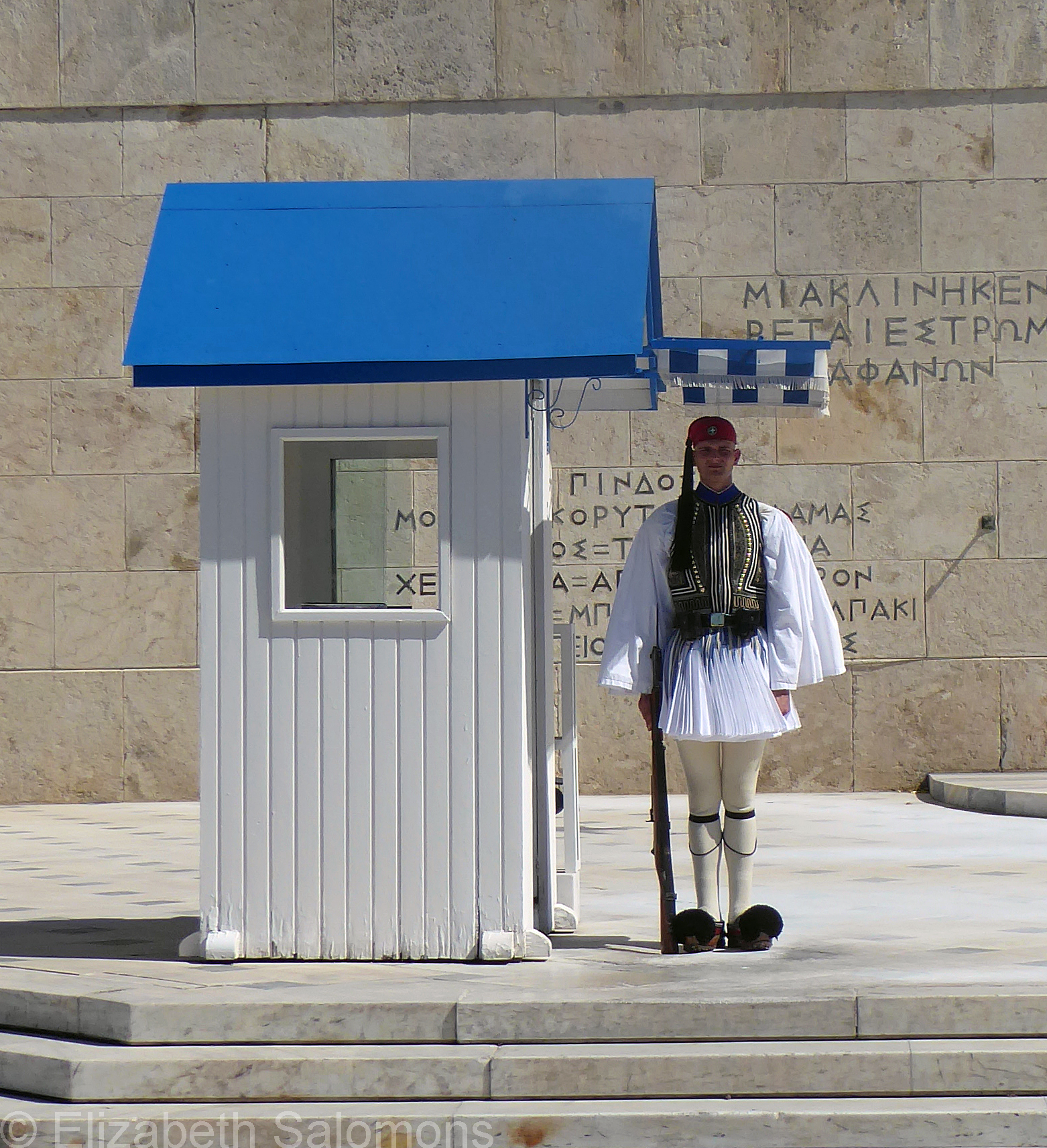
Despite a past-midnight arrival all the way from Vancouver the night before, on my first morning in Athens, I hoofed it up to Syntagma Square to see the changing of the guard outside the Greek Parliament. A small ceremony takes place hourly, but on Sunday mornings, there is a more elaborate ceremony with an entire platoon taking part and I was keen to see it.
Truth be told, I can’t resist a fine uniform. Or a marching band.

The unique uniform of the Greek Presidential Guard has its origin in those worn by the soldiers who liberated modern Greece from the Ottomans. Officially adopted in 1867, they take six months to make (stitched entirely by hand) and one hour to put on. The skirt has 400 pleats, representing the number of years that Greece was under Ottoman control. The white colour of both skirt and shirt symbolizes the purity of Greece’s struggle for independence.
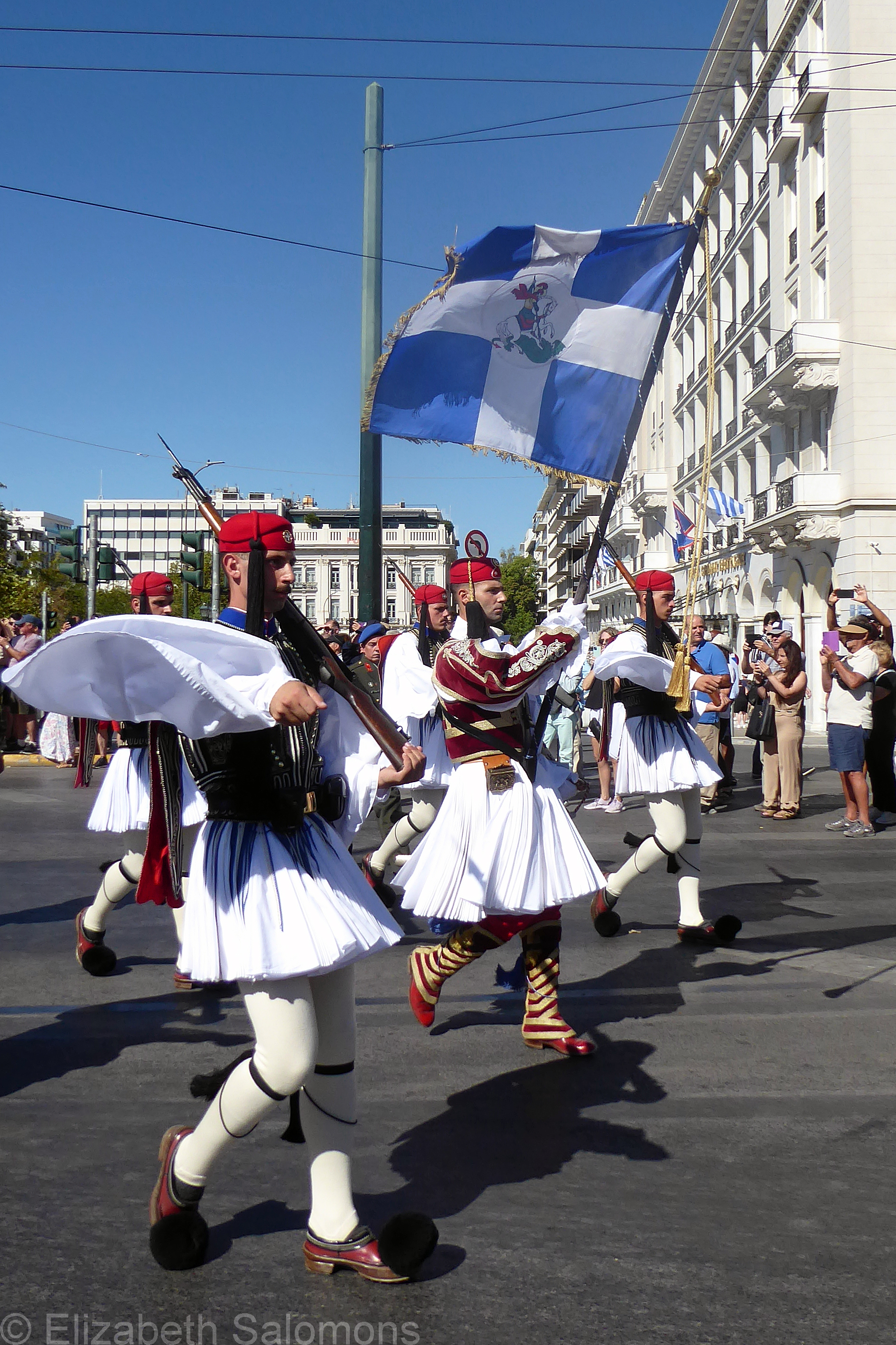
The vest takes the most time to make as it involves intricate embroidery. The red cap symbolizes the blood spilled by the soldiers, and the black tassel symbolizes the tears shed in mourning. The shoes are handmade and based on footwear worn since Byzantine times. The distinctive pompom was originally added to help make the toe waterproof.
A bit of Google research gave me tips as to where to stand to get the best photos. When the crowds got to be too much for me, I wiggled my out and found a spot alongside the street I knew the soldiers would leave by.
I got lucky. Right place, right time.
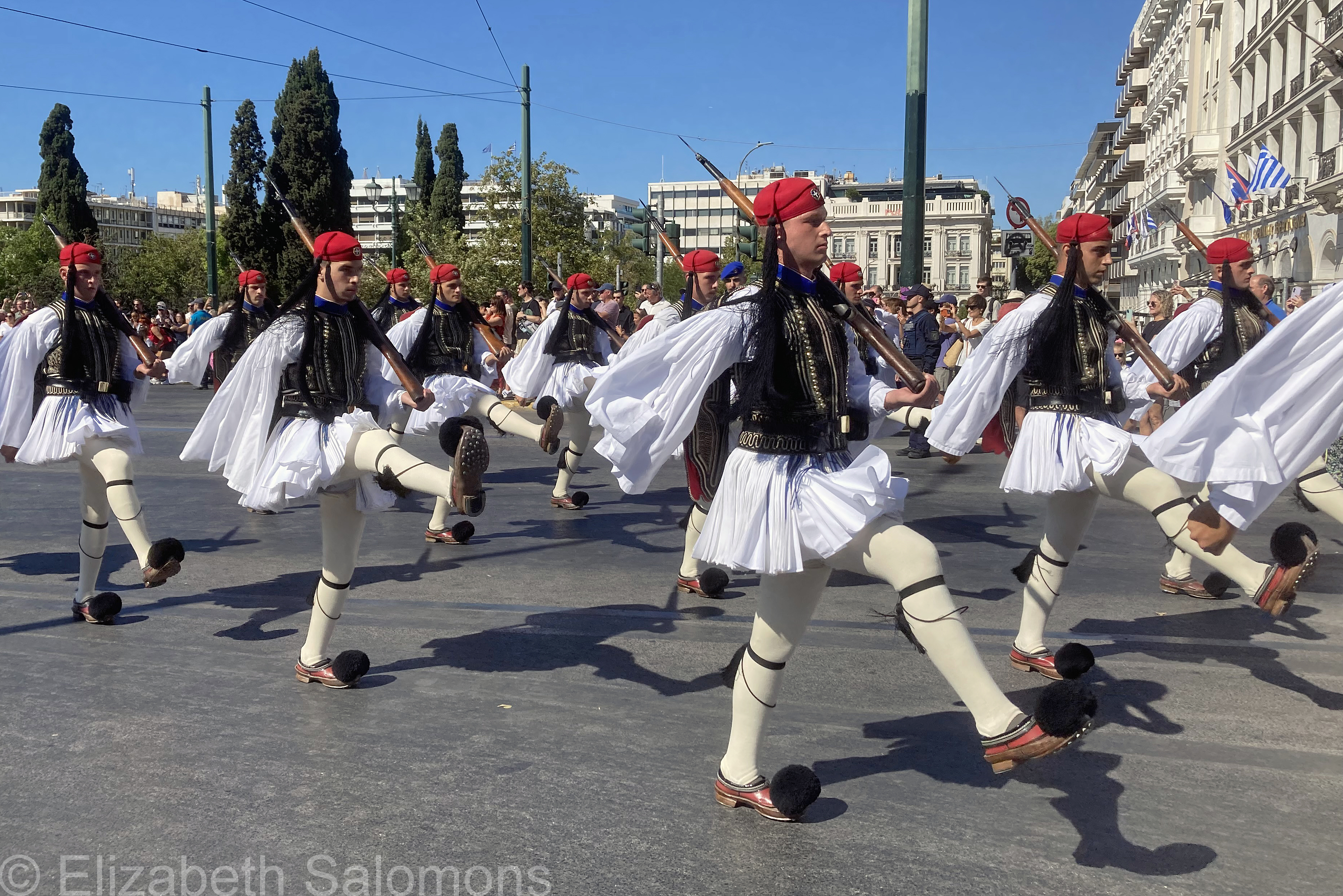
The Acropolis
Since every time I turned around in Athens, I saw the Acropolis, it was only a matter of time before I got up close and personal.
The Acropolis is a sprawling complex of ruins that sits up high on a rocky plateau overlooking the city. Its name says it all: the word comes from the Greek akron (high point) and polis (city).
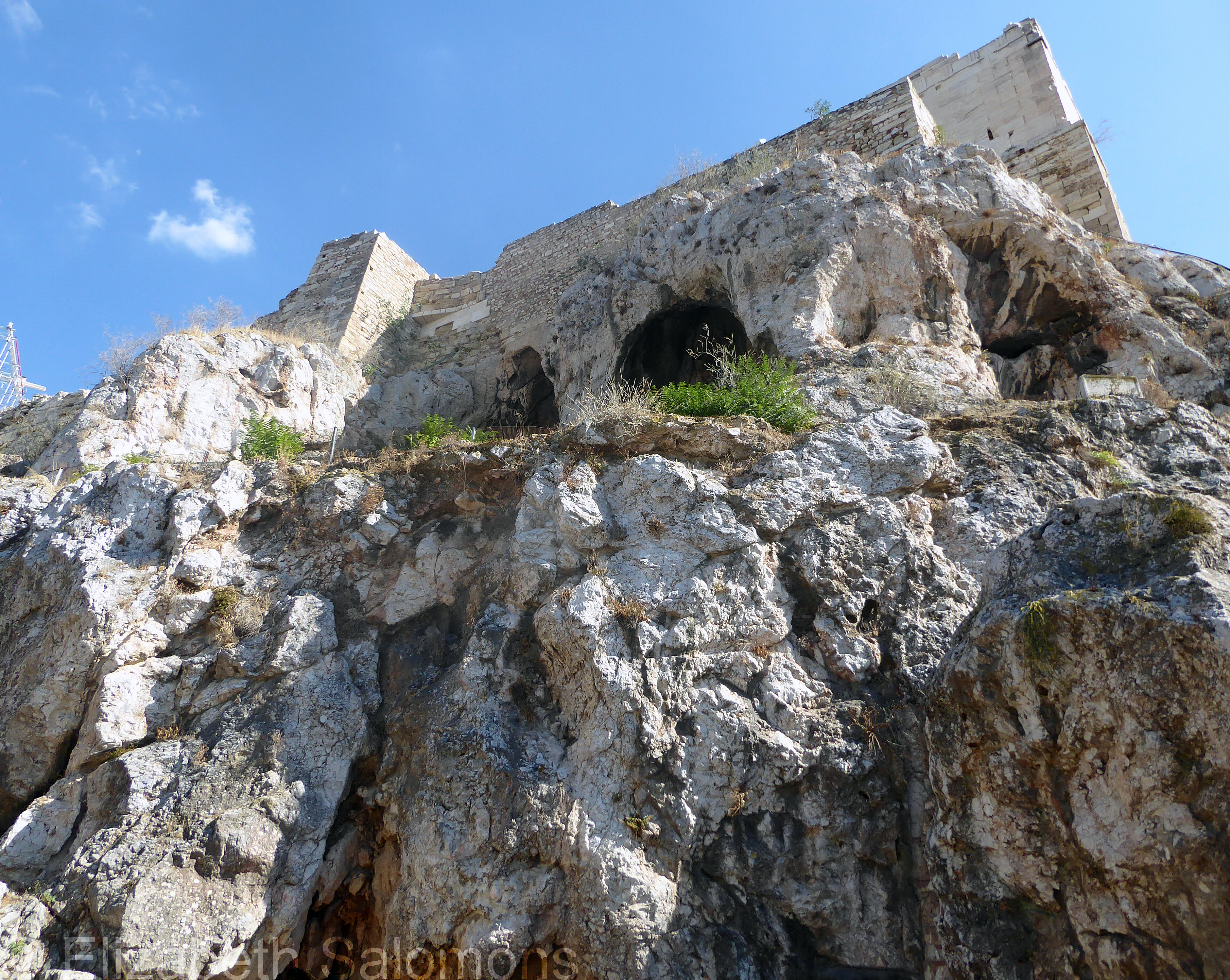
The first fortifications went up in the thirteenth century BCE and had a military purpose; around eighth century BCE, the site shifted to a religious focus dedicated to Athena, the goddess of Athens. A massive building program undertaken in the fifth century BCE resulted in the structures that have showcased ancient Greek’s architecture and art ever since.
I came in by the southeastern entrance, where a switchback trail leads you slowly up the hillside (called the “slopes”), past many ruins that serve as a teaser for the main event.
The Theatre of Dionysos is also located on the southern slopes. First built out of wood in the sixth century BCE, it was redone in stone and marble three hundred years later. It had room for 17,000 spectators seated in 64 tiers, of which 20 still survive.
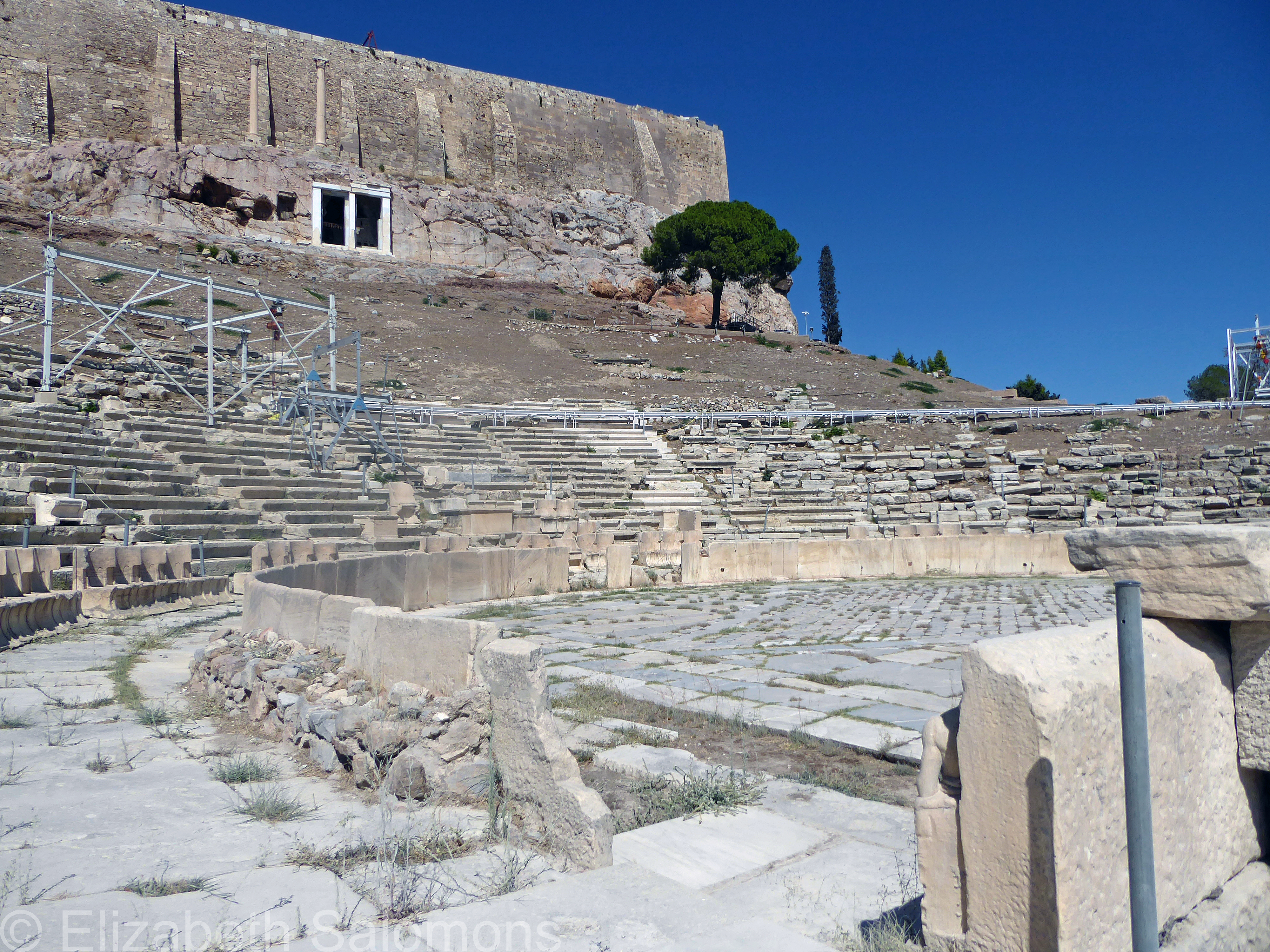
The Propylaea, built between 437 and 432 BCE, marks the entrance to the Acropolis. It was the only part of the Acropolis where I could not manage to get a photo without massive numbers of tourists.
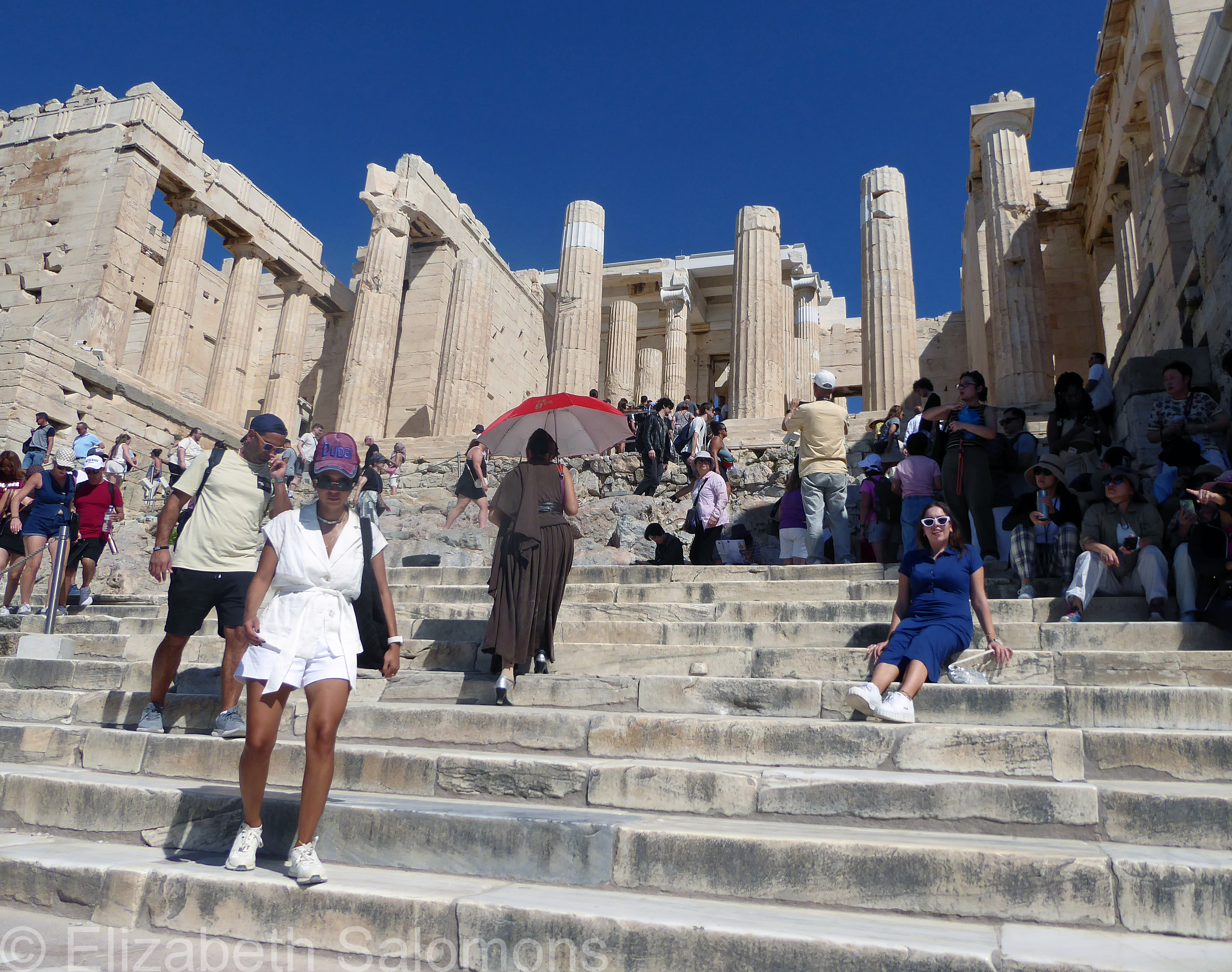
The Temple of Athena Nike (Athena as Victory) was completed in 425 BCE. It stands slightly before the Propylaea.
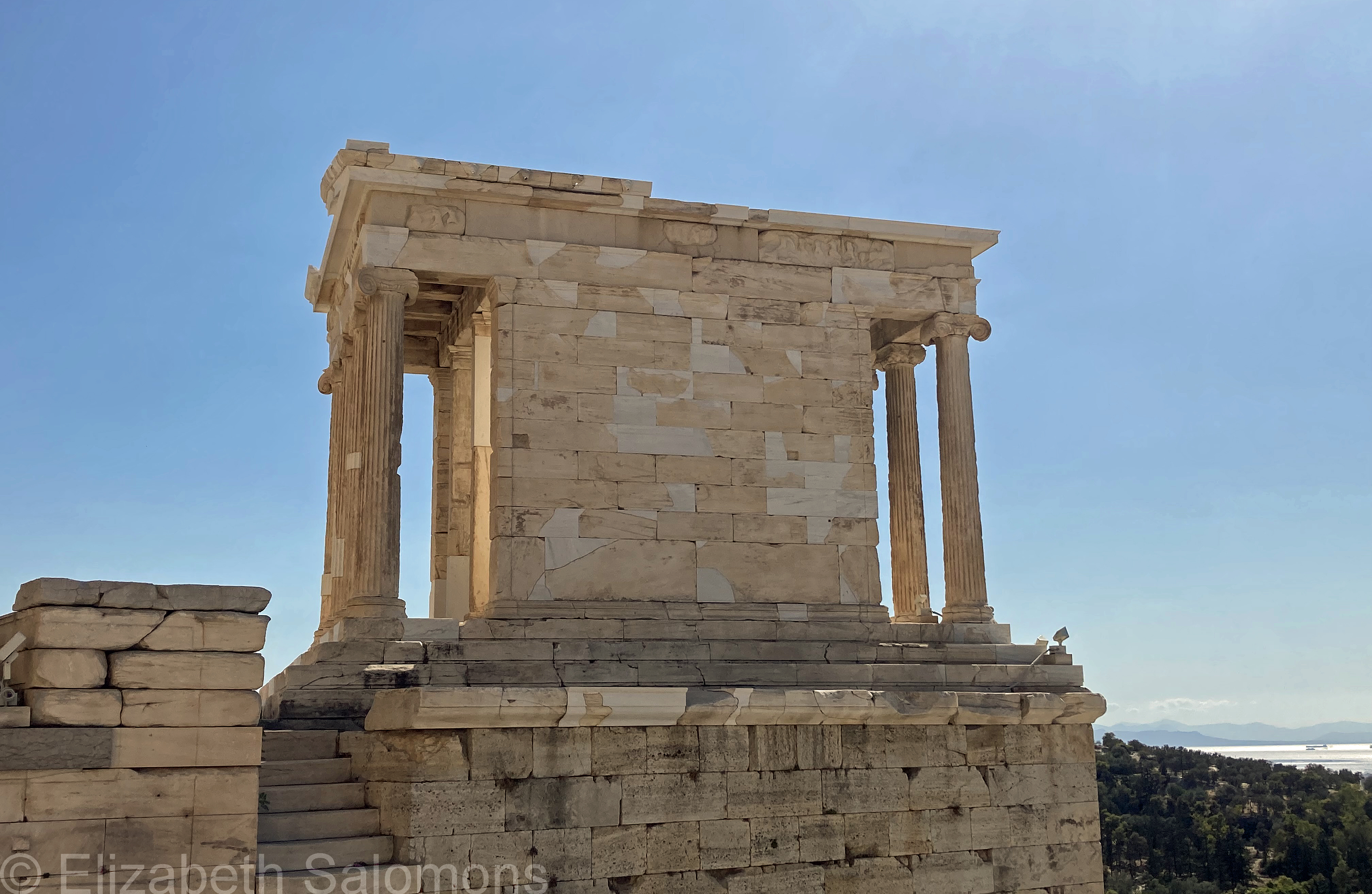
The Temple of Athena Polias (Athena of the City), or the Erechtheion, was finished in 406 BCE. This Ionic temple was built on the holiest part of the Acropolis, where Poseidon (god of the sea) struck the ground with his trident, creating a spring, and where Athena (goddess of wisdom) planted an olive tree.

(Quick aside: Athena and Poseidon were competing to see who would be patron of the newly founded city-state. The water in Poseidon’s spring was salty and so the citizens chose the olive tree, which would provide them with food, oil, and shade. This made Athena the winner and gave the city its name.)
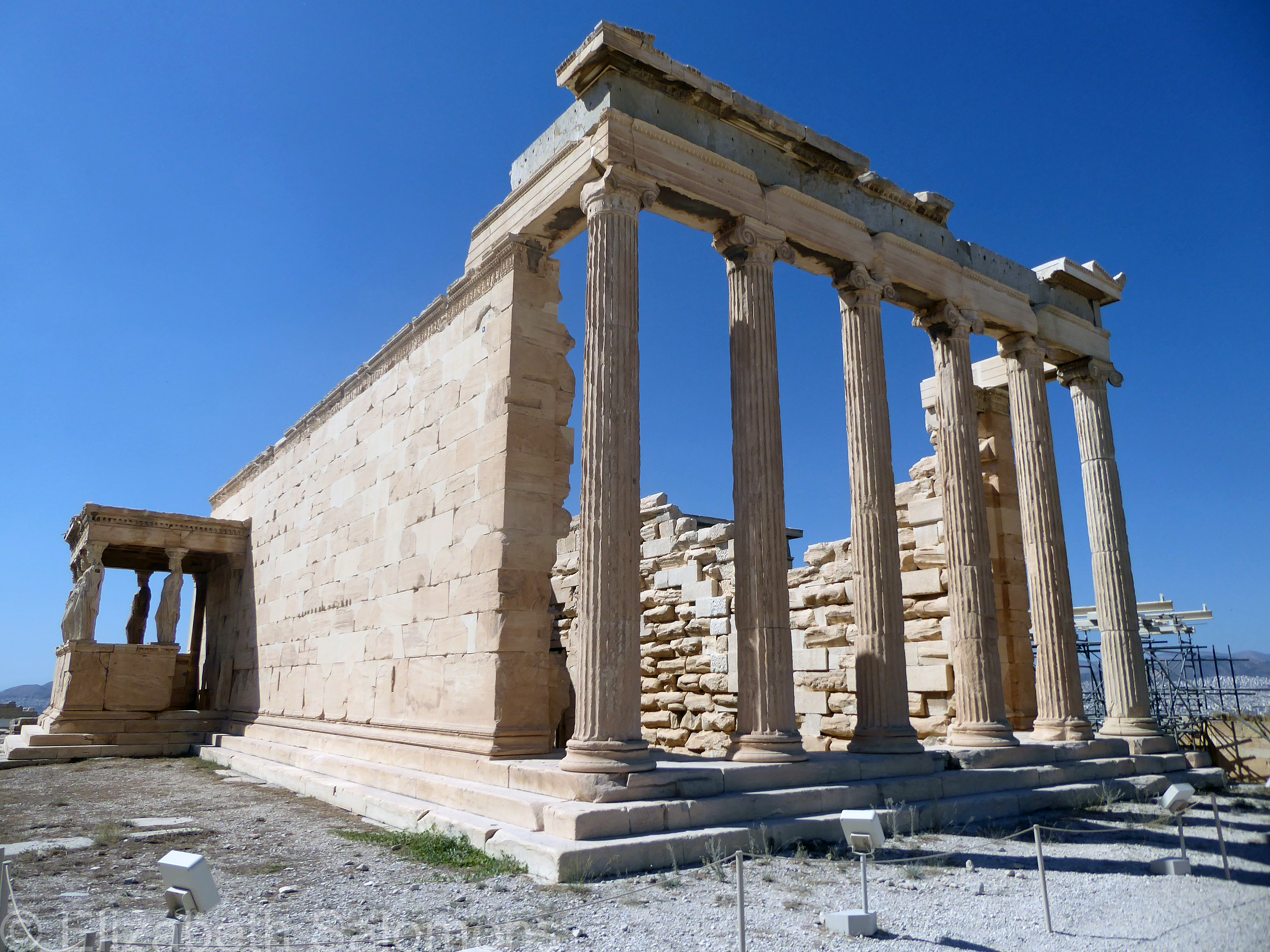
The six maiden columns of the Erechtheion, called the Caryatids, were completed in 415 BCE. The ones here are plaster replicas. Five of the originals are in the Acropolis Museum and the sixth is in the British Museum.
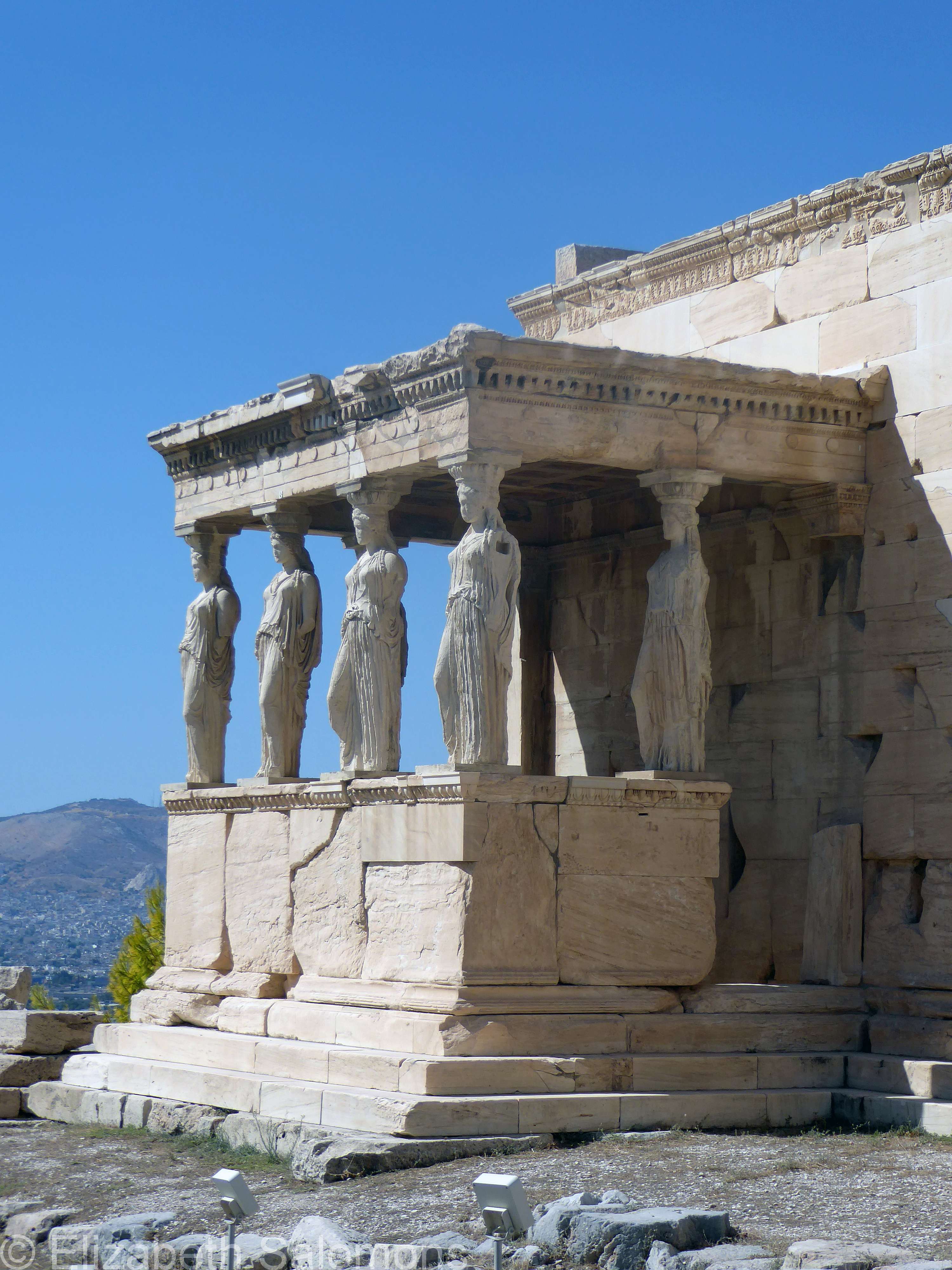
The largest structure on the Acropolis site is the Parthenon. This Doric temple, completed between 447 and 438 BCE, was dedicated to the goddess Athena Parthenos (Athena the Virgin). Its foundations are slightly concave and the columns slightly convex — an optical illusion that allows both to appear straight. When it was first built, its friezes were brightly painted.
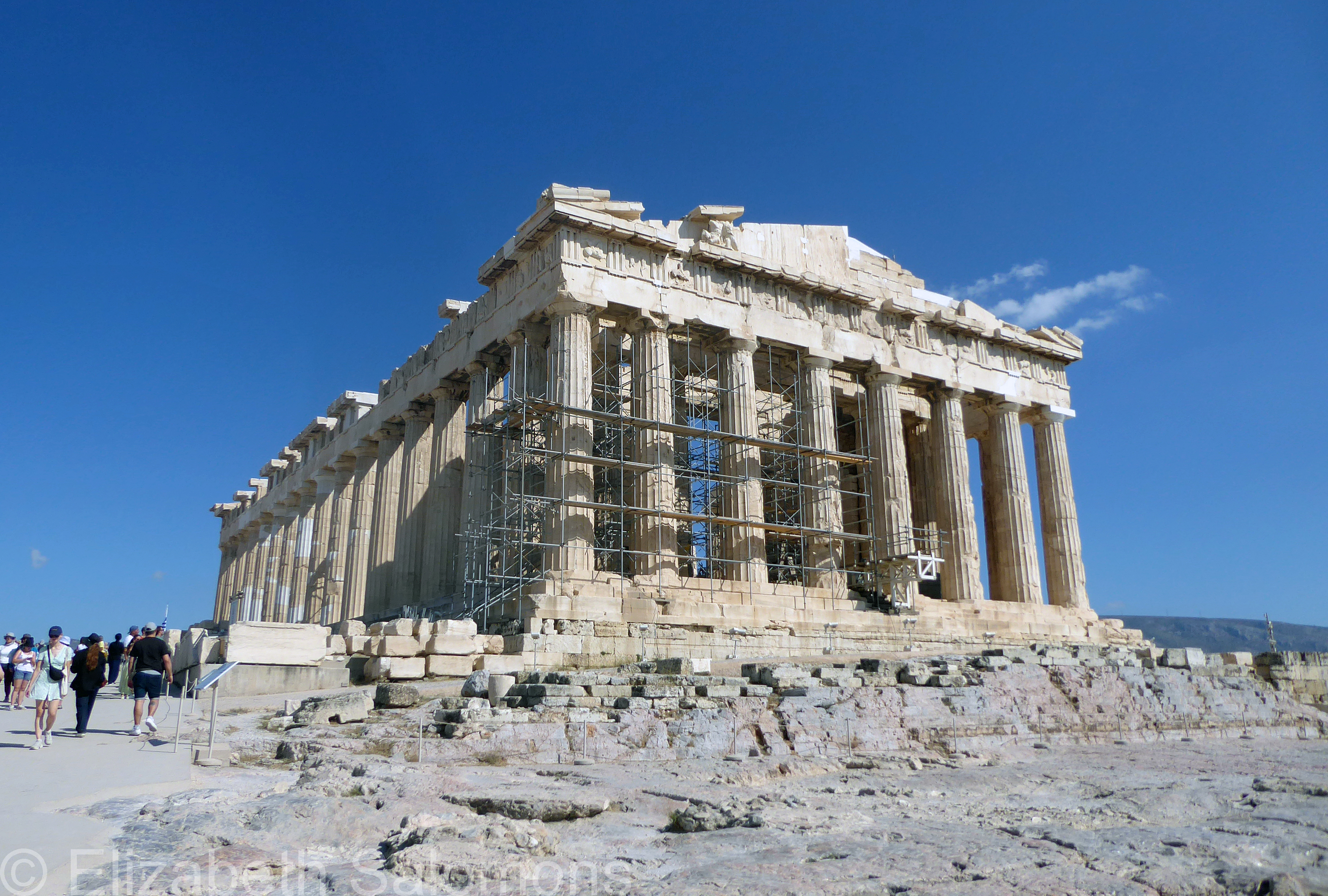
Sometime in the late third or fourth century CE, the interior of Pantheon was destroyed in a fire. In the sixth century CE, it was converted to an Orthodox church. In 1204, crusaders turned it into a Catholic church. When the Ottomans conquered Athens in 1458, it was converted to a mosque. And in 1687, when the Venetians held a siege of the Acropolis, a cannonball made a direct hit on the Parthenon. As it was being used as a powder magazine, the explosion destroyed the roof and much of its walls.
But the most severe damage to the Parthenon? That was between 1801 and 1812, when Lord Elgin carted half of its remaining sculptures off to England, along with sculptures from the Erechtheion, the Temple of Athena Nike, and the Propylaea. They remain there, displayed in the British Museum. The Greeks, naturally, want them back. The Elgin Marbles have been a source of tension between the two countries ever since.
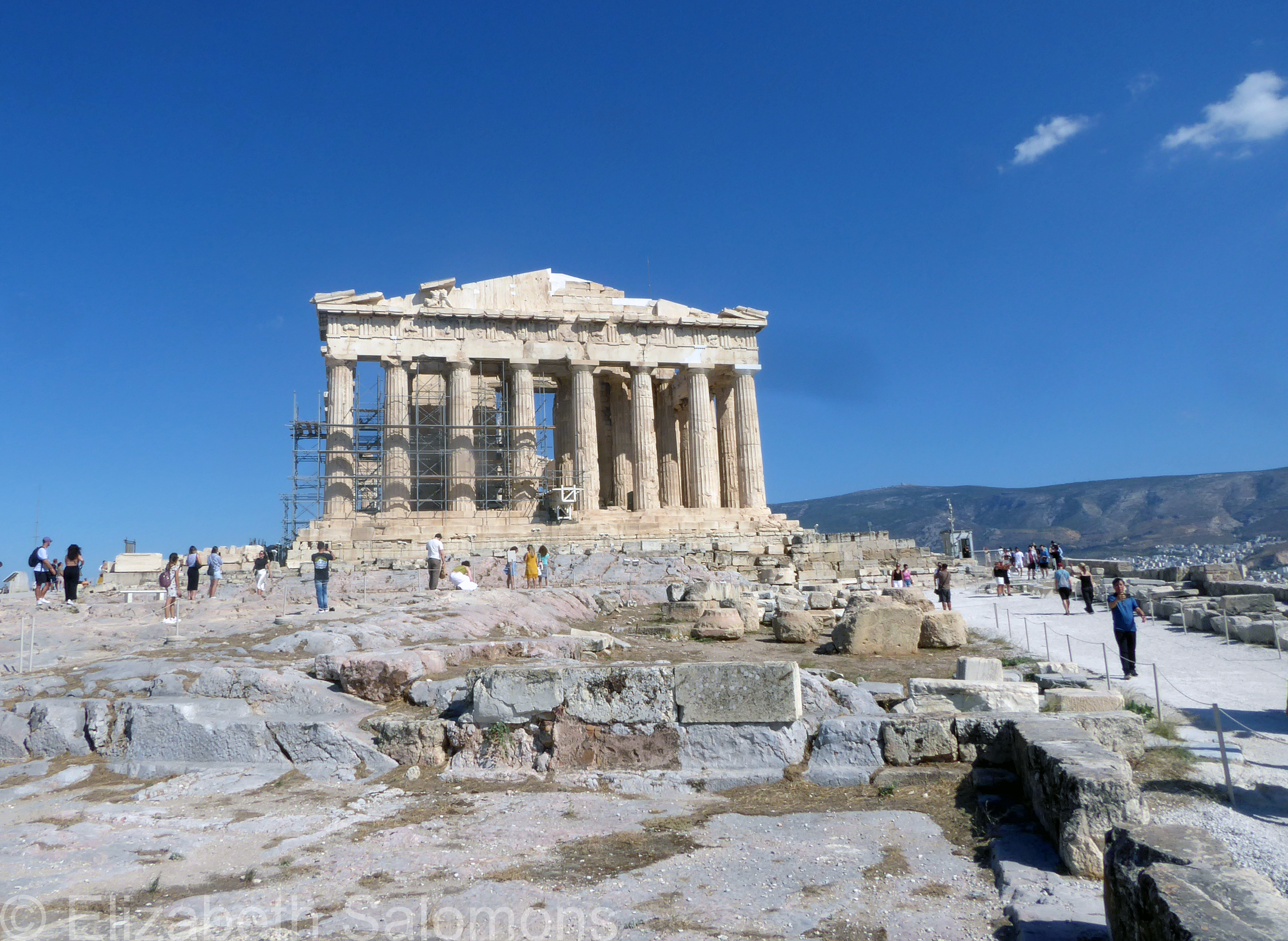
It doesn’t take long to walk through the Acropolis. I took my time, stretching my visit out to almost two hours (spent mostly waiting for people to move out of the frame as I took my photos), but you could speed through the entire complex in 30 minutes if you were in a rush. Bring plenty of water — it was hot, even in late September, and there’s no shade.
The Acropolis has been operating as an archaeological site since 1833, shortly after the establishment of the modern Greek state. It has always served as the religious and cultural centre of Athens, but it is also a symbol of the birthplace of democracy and the foundation of Western civilization. Yeah, no pressure there. Given the increasing fragility of democracies around the world (particularly noticeable this year, I might add), today seems like a good day to reflect on that legacy.
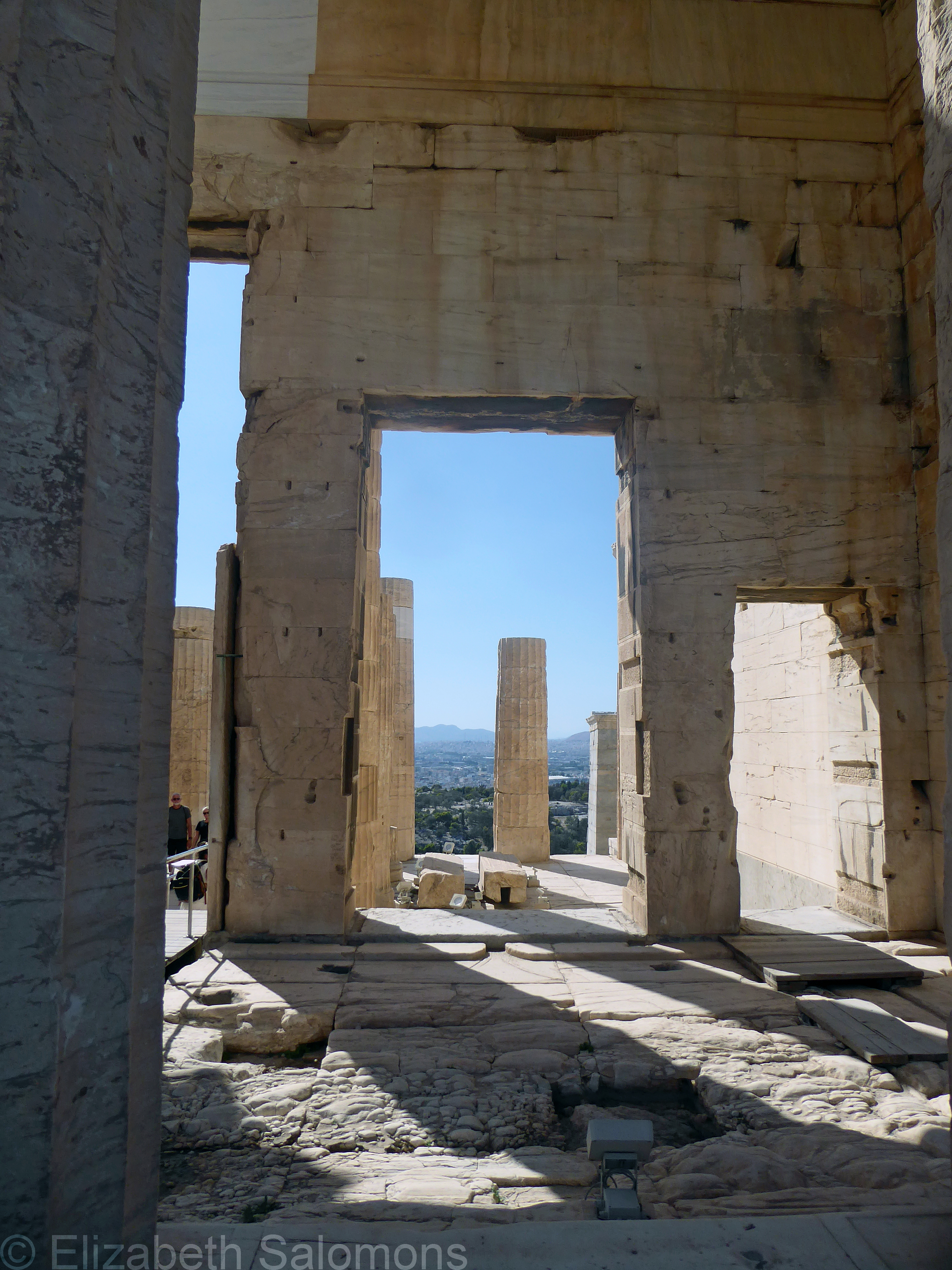
Merry Christmas!
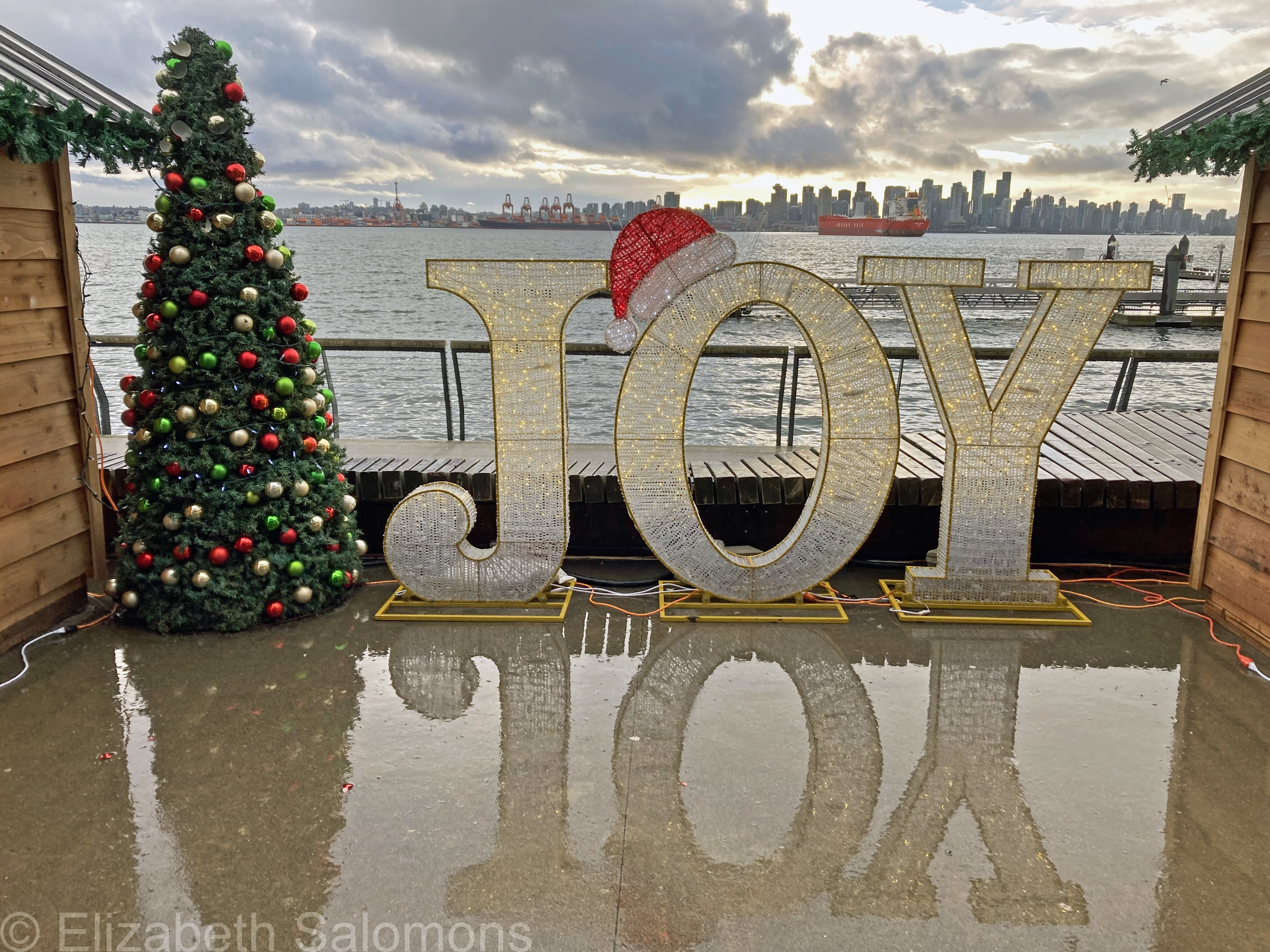
Shipyards Christmas Market, North Vancouver
Through My Lens: Shipyards Christmas Market
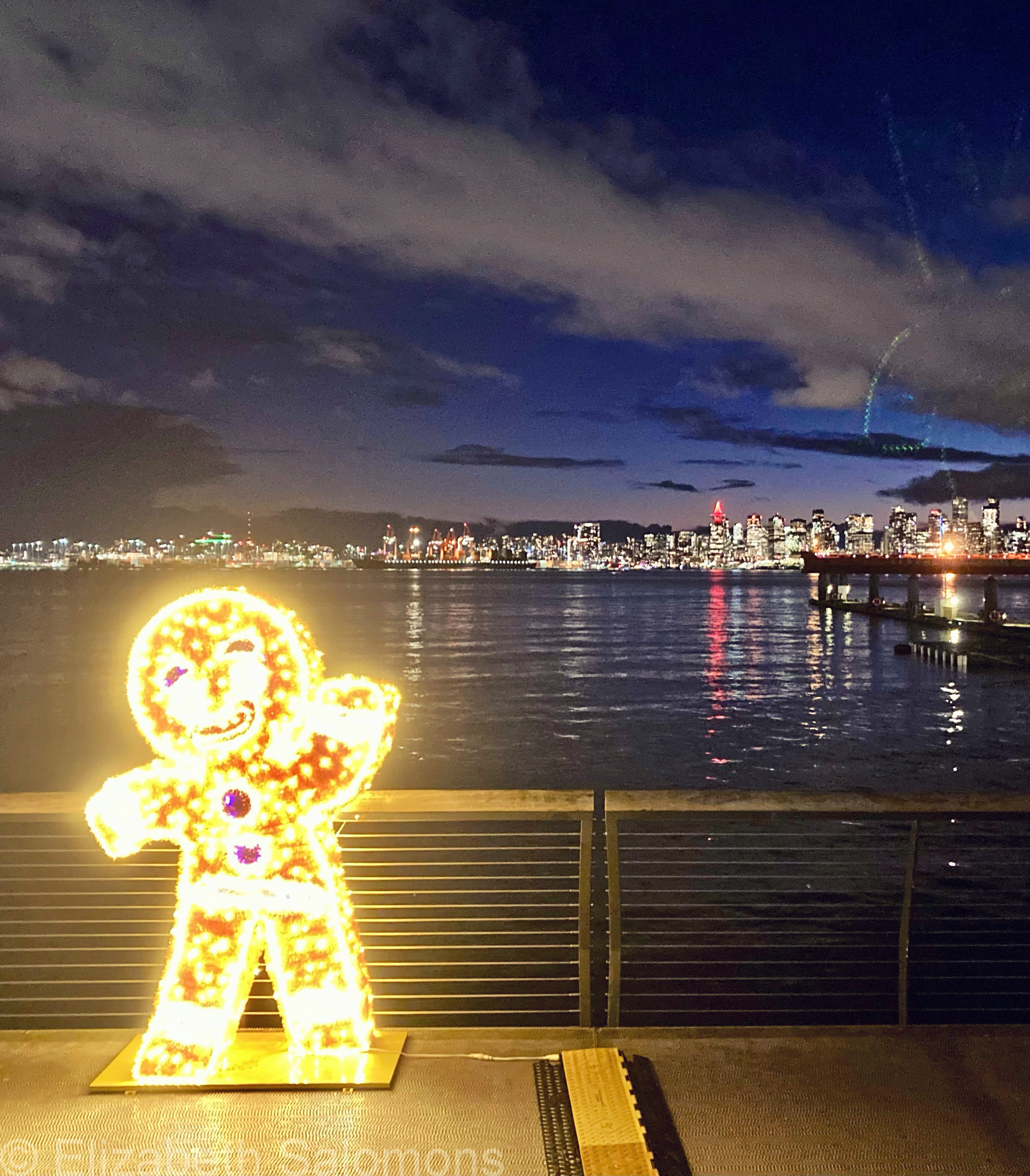
There’s a new Christmas market in town and I, for one, am beyond happy about it. Located at the Shipyards District in North Vancouver, it’s already two years old and this year’s market is even bigger and better than last year’s. In fact, it’s become so popular, they’ve put on extra sailings of the SeaBus to get you there.
And, bonus: that view of downtown Vancouver.
Happy Birthday, Jane Austen!
I wasn’t planning to write about the semiquincentennial of the birth of Jane Austen, born on this day in 1775. After all, I’d already written a post on the bicentennial of her death some years ago.
But when I woke up this morning, I thought, “C’mon. It’s Jane Austen! You need to post something.”
However, I’m a bit low on photos that represent Jane. The only place I’ve been to that connects with her life is Bath — and she didn’t much care for Bath. I was planning to visit Winchester, where she died and was buried, and where the house she lived the last eight years of her life has been turned into a museum.
In fact, I left Bath fully intending to go directly to Winchester. But after changing trains in Southampton, and realizing the train I had boarded was continuing on to London after it stopped in Winchester, I changed my mind. (You can do things like that with a BritRail Pass. I have to say: it’s very freeing, travelling that way.)
And so, I ended up in London that night. Winchester — and Jane Austen — would have to wait.
I always say, when travelling, that you should leave something undone to make sure you come back. One of these days (years?), I will return to Jane Austen country.
In the meantime, in honour of Jane Austen’s 250th birthday, here’s a photo of the Roman baths in Bath. I like the idea that Jane and I have both been to these baths — even though I missed her by almost 200 years.

Views of the Acropolis
The first thing I noticed while in Athens is how you see the Acropolis rising above the city every time you turn around. (It made me think of Paris, where you see the Eiffel Tower every time you turn around.)
Here are a few of the views I captured.
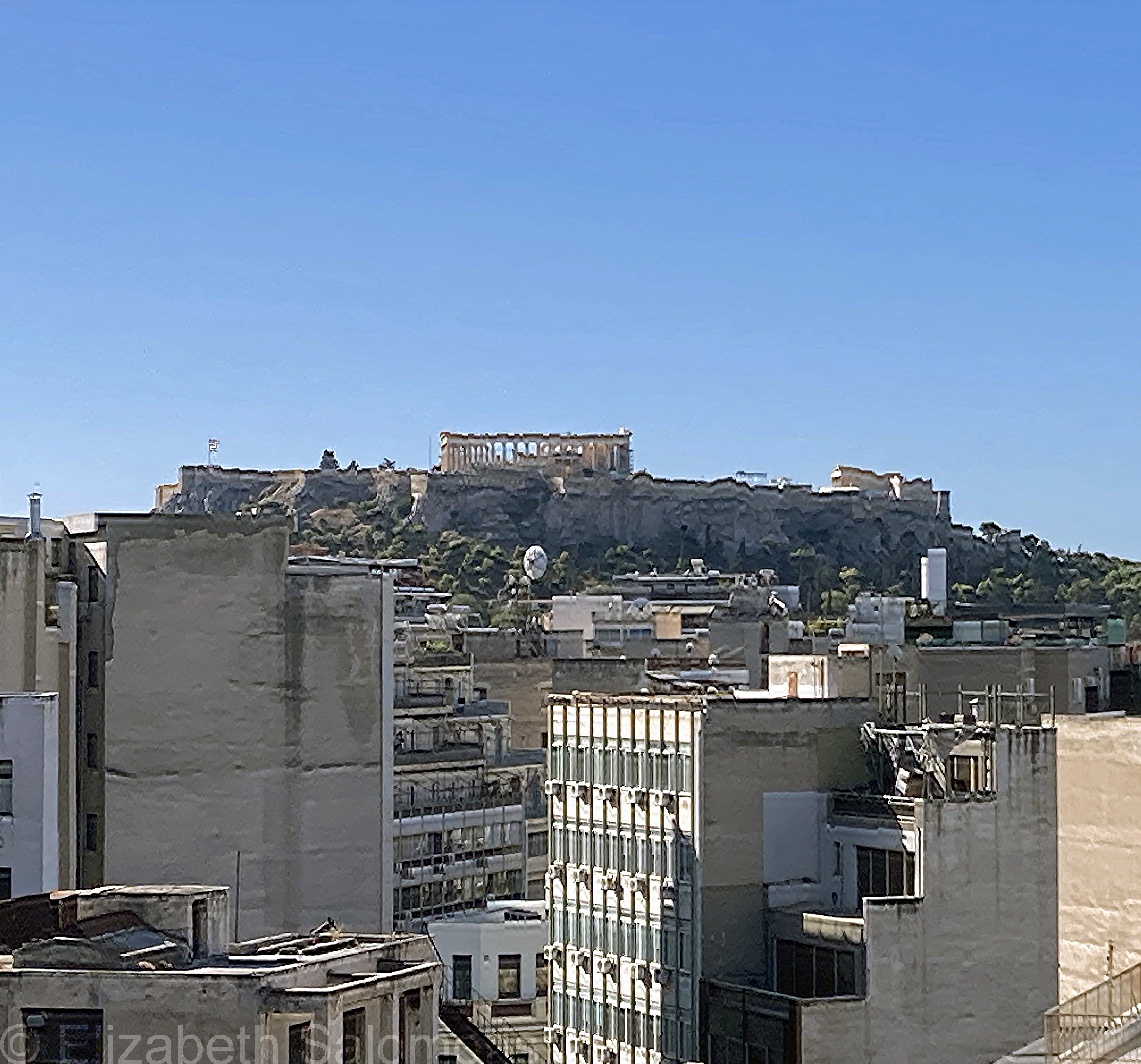
From the breakfast room at my hotel

From the top floor of the Maria Callas Museum

From the Acropolis Museum

From the Pnyx
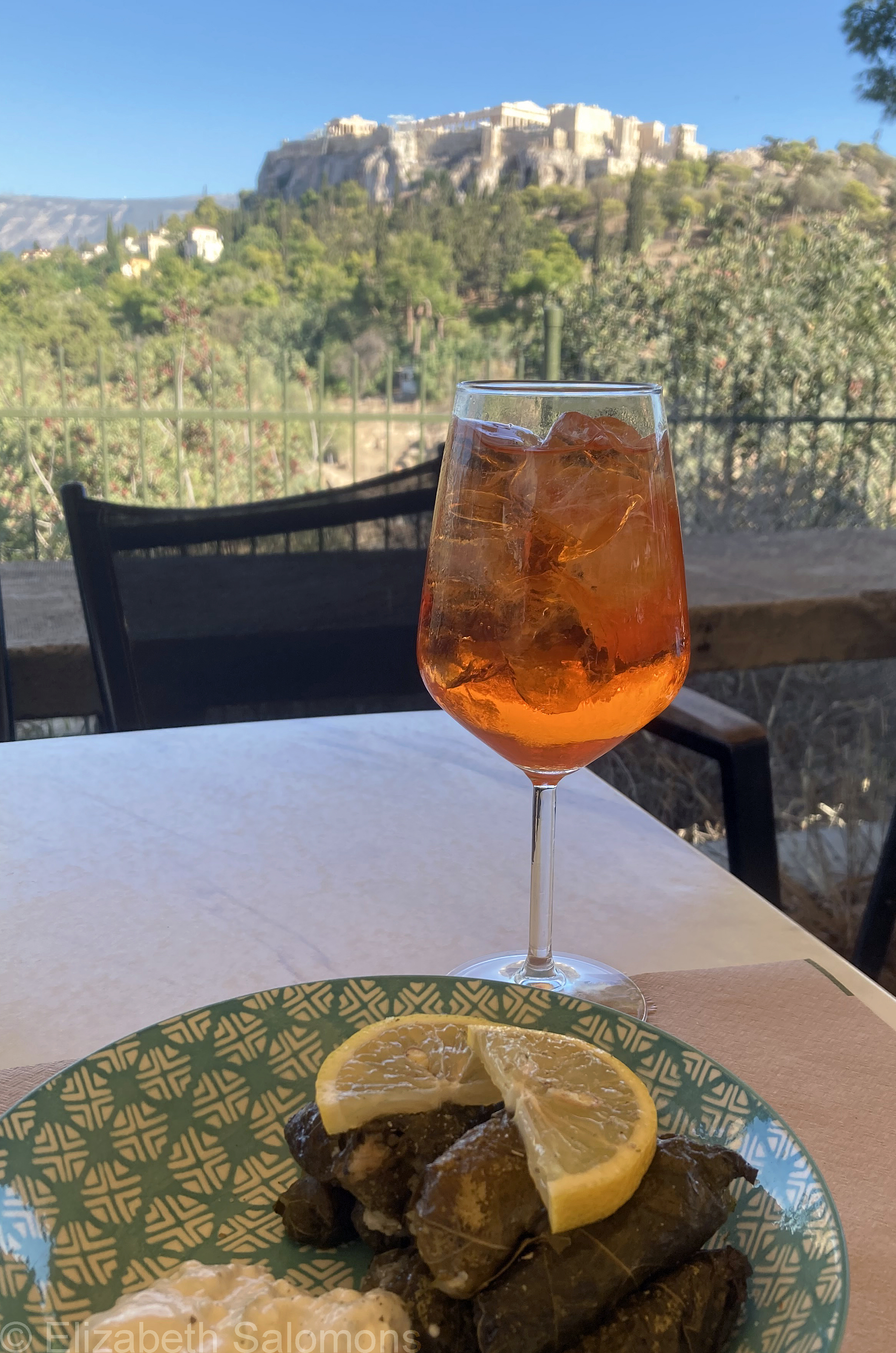
From Plateia Jacqueline de Romilly (while enjoying
an Aperol spritz and some dolmadakia)
Through My Lens: Sea Squill on Serifos

One advantage of travelling solo, I (re)discovered this past fall, is that nobody gets impatient when you stop to take yet another photo. It took me several tries to get a shot I was happy with of this plant, which I came across one day while wandering the hillsides of Serifos, a Cycladic island in the Aegean Sea. (I’ve since learned that the plant is called a sea squill.)
I have lots more photos to share from my month in the Mediterranean.
Let’s get started.
Vancouver Goldeneyes Home Opener
Vancouver gets behind its professional sports teams in a pretty big way. And now there’s a new team in town to cheer on. That would be the PWHL’s Vancouver Goldeneyes.
I was one of 14,958 lucky fans sitting in the Pacific Coliseum last night who got to watch the season home opener and the first game in franchise history. The atmosphere was electric.
The Goldeneyes are the first Professional Women’s Hockey League (PWHL) team to be an anchor tenant in their arena. Which means they are the only PWHL team that gets to play on ice branded with their team logo. It may seem like a small thing, but if you listen to the media interviews the players gave after the game, you realize, for them, it is huge.
These photos aren’t the greatest as I was shooting with a four-year old iPhone that’s pretty bad with distances. Even so, it was fun documenting a series of franchise “firsts” and I’m so glad I was there.

First sell-out game
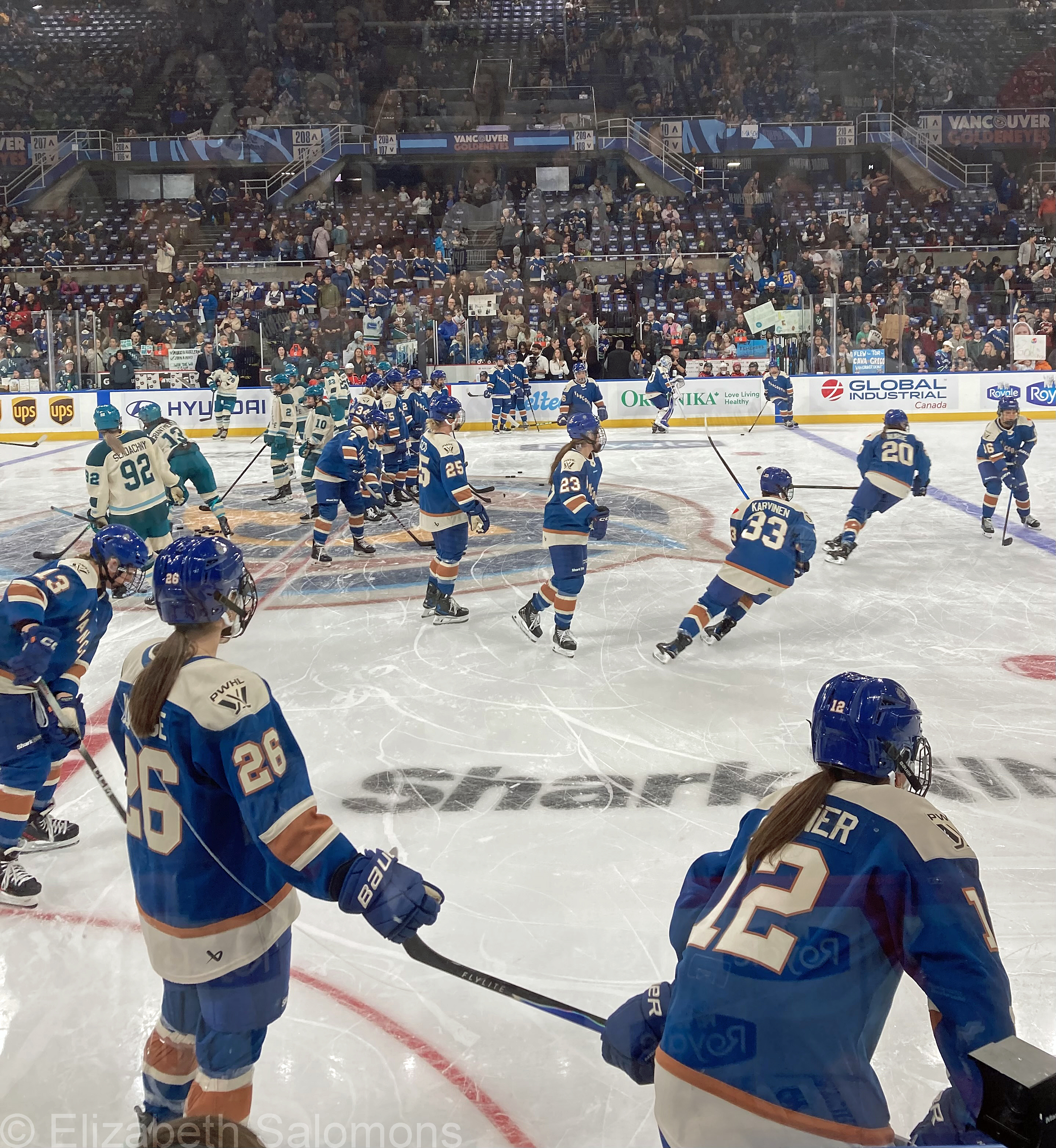
First warm-up

First ceremonial puck drop
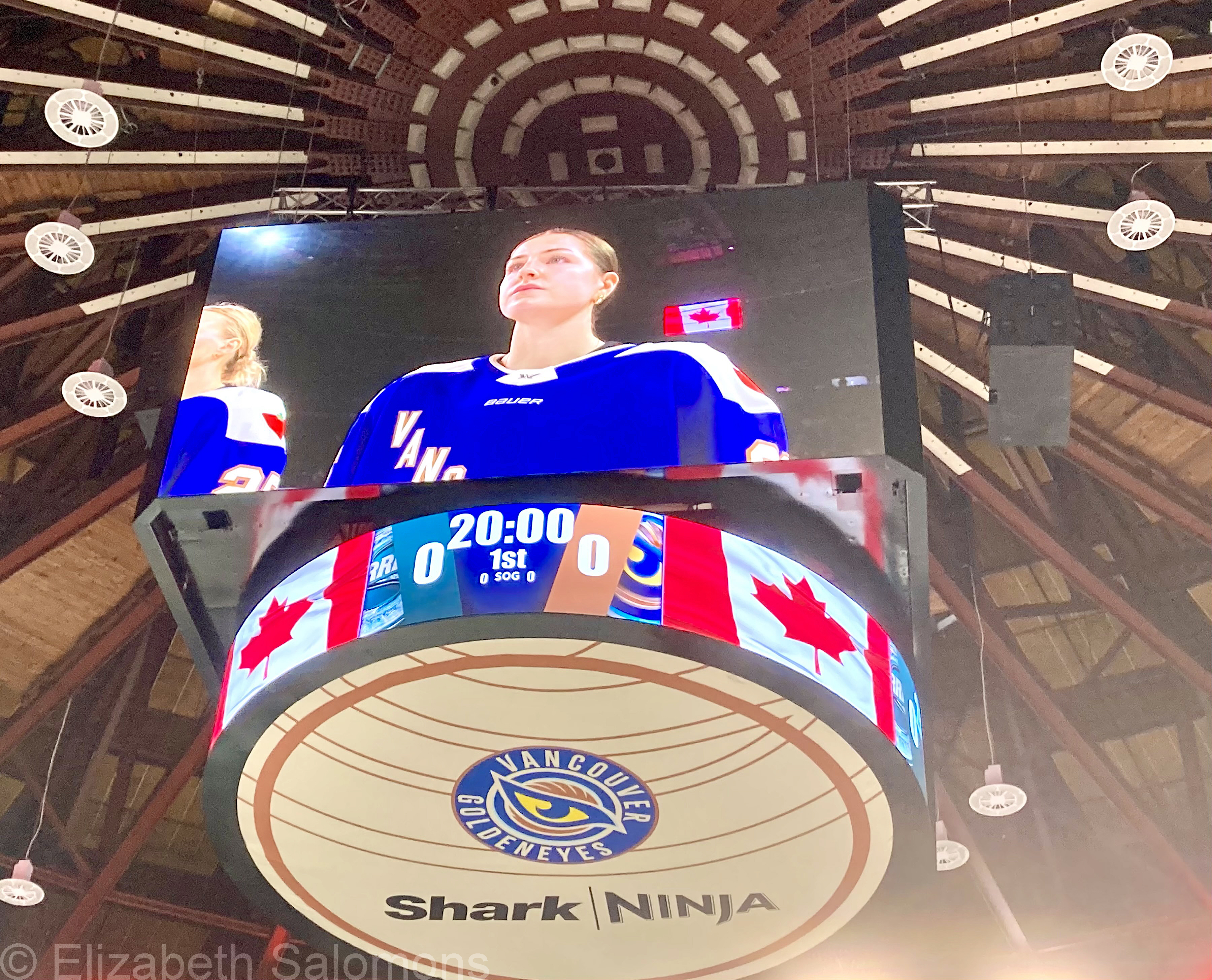
First national anthem
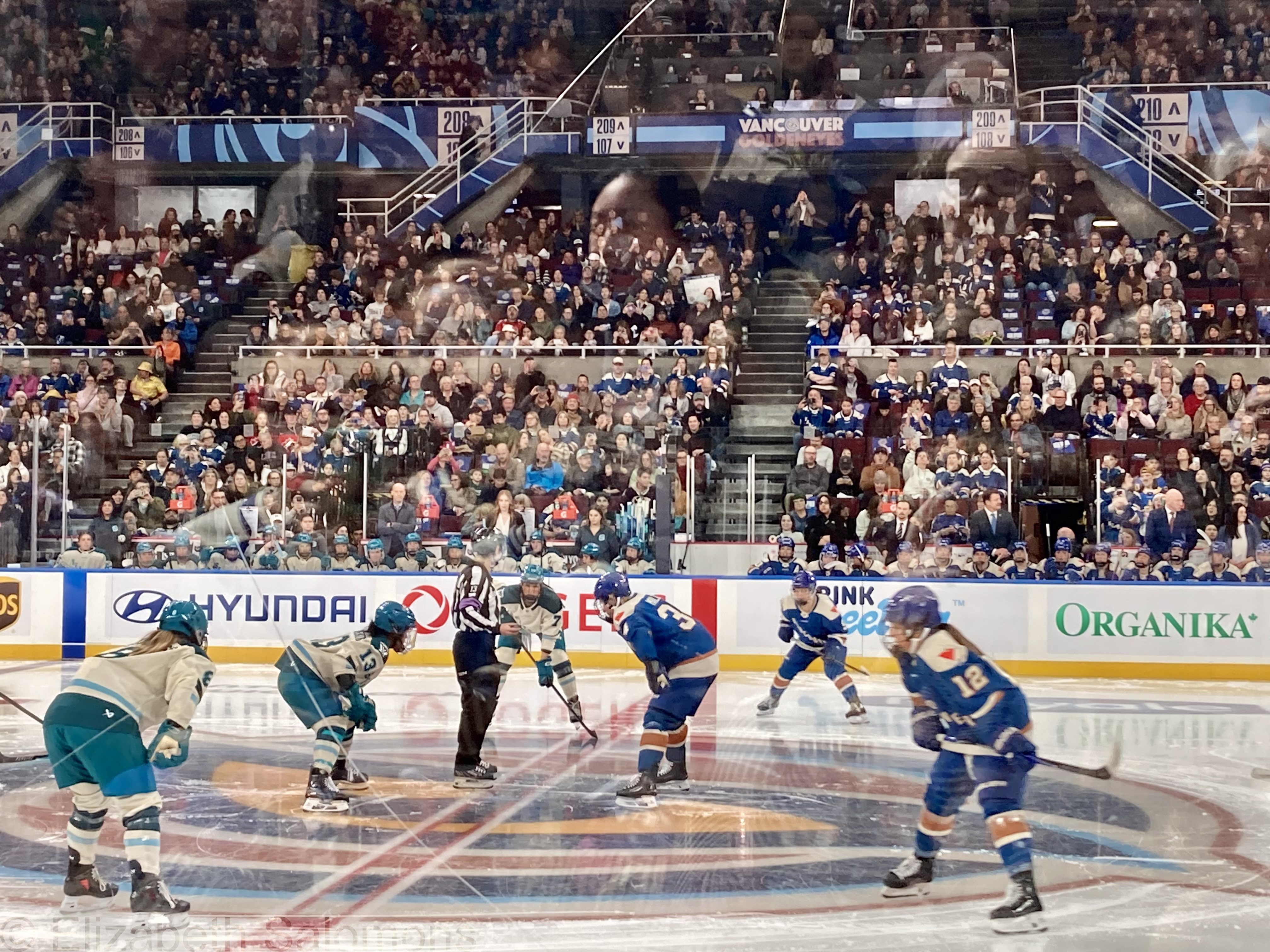
First game puck drop
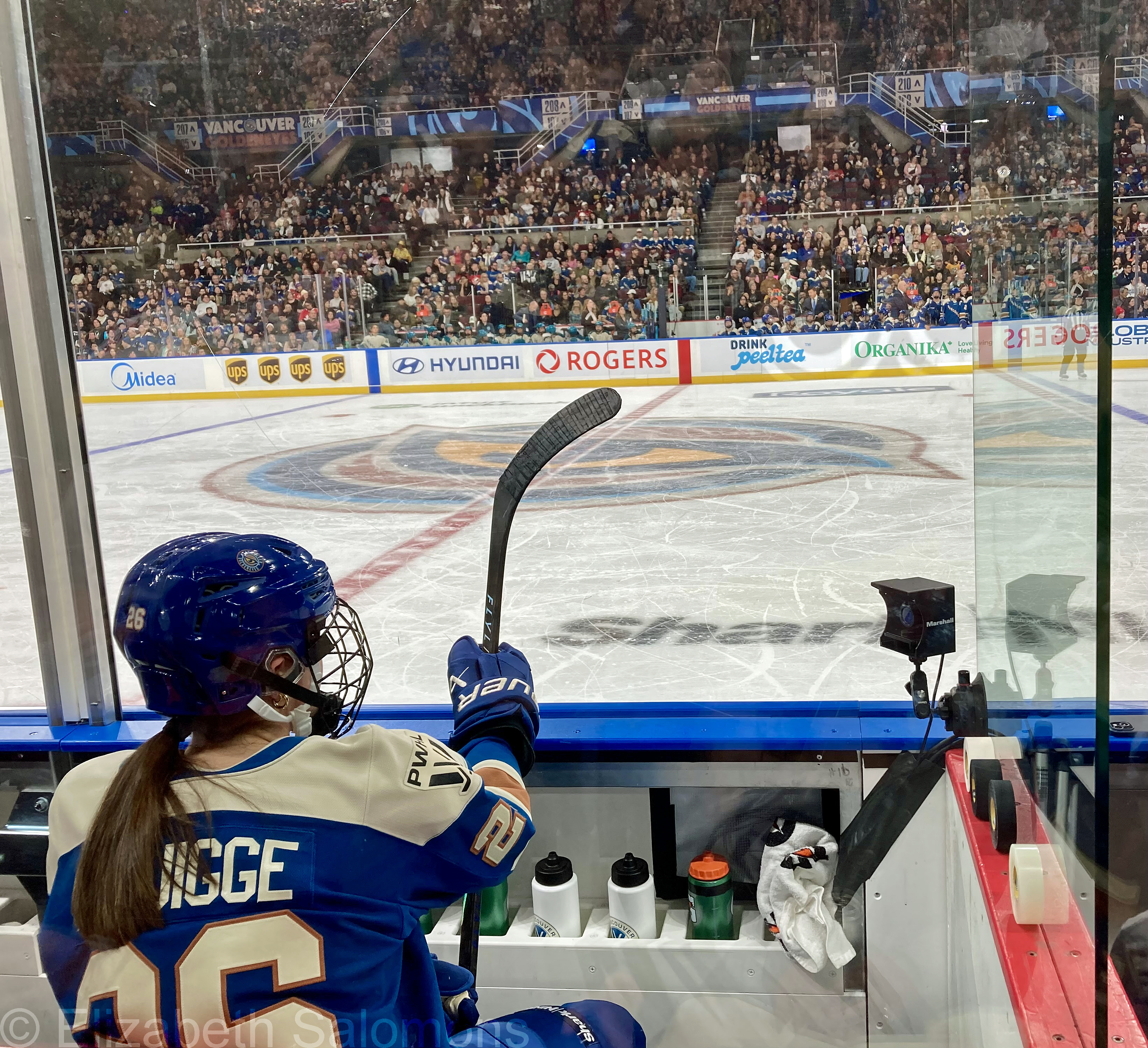
First penalty

First win
Through My Lens: Alberta Highway 540
A couple of times a year, I make the trek from Vancouver to Calgary (by plane) then on to Lethbridge (by car) to visit family — as I did last weekend. But instead of taking Highway 2 all the way back to Calgary as I usually do, I decided to make a left turn somewhere north of Nanton and south of High River onto Highway 540. And I’m so glad I did.
I mean, c’mon. Just look.



